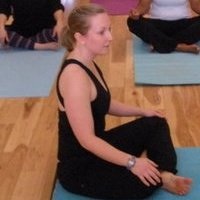 By Meryl Arnett (@merylarnettyoga)
By Meryl Arnett (@merylarnettyoga)
Catch up on the rest of the series!
–Mile 1: The Power & Pain of Five Days of Meditation
–A Detour into Mediation (VIDEO)
Yoga Therapy has been an interest of mine ever since pursuing my original teaching certification. I love the idea of using yoga to heal and bring someone back from an injury or illness stronger than they were before. Through Pranakriya, I am pursuing both my 500-hour teaching certification and my yoga therapy certification. My most recent training, Functional Anatomy, was one of the required modules for both certifications and to date, one of the most immediately useful trainings I have taken.
In the original 200-hour training, our anatomy studies consisted of learning the bones and major muscles of the body. Now, with this more advanced anatomy training, we took that basic knowledge deeper into the relationships between joints, muscles and ligaments. It broke down many common injuries such as sciatica, knee pain, ankle sprain, carpel tunnel syndrome and arthritis to give us a better understanding of what is happening in the body and how yoga can address these common issues.
What fascinated me the most was the commonalities between addressing different issues. With most underlying issues, yoga’s purpose is to create space and strength around the injury, allowing it the opportunity to heal and perhaps reverse previous imbalances. The true difference in therapies can come from the postures we use to allow healing. In some cases, if lengthening the hamstrings is needed, we may choose to do a stretch standing at the wall but for others, that same stretch might need to happen lying on the side of the body.
 The beauty of yoga therapy in my mind is not just the opportunity to stretch and strengthen but to also incorporate the breath and the mind. It is proven that slowing the breath (Ujjayi, anyone?) will help the muscles to relax; with deeper breath, instead of contracting against a deep stretch, the muscles will relax and lengthen.
The beauty of yoga therapy in my mind is not just the opportunity to stretch and strengthen but to also incorporate the breath and the mind. It is proven that slowing the breath (Ujjayi, anyone?) will help the muscles to relax; with deeper breath, instead of contracting against a deep stretch, the muscles will relax and lengthen.
As a yoga instructor, this knowledge is not just useful in yoga therapy sessions but in our day-to-day classes. If a student walks in with a pre-existing condition or if they feel pain in a pose during class, this training allows me to address those issues more fully and with more confidence than when I first started teaching. While I would never profess to know how to heal an injury or to make a diagnosis myself, I do know that careful application of yoga breath and yoga poses will benefit anyone, regardless of situation.
Have an injury or dealing with an ongoing pain? Mention it before class and see what your teacher can offer you! I always try to add in a few poses I know will address whatever issues my students mention before each class, and I will often give them specific modifications or postures to do in class or at home.
As we roll into 2012, I am looking forward to several more training modules including Advanced Pranayama, Musculoskeletal Assessment and a review of the Hatha Yoga Pradipika. Stay tuned as we continue our journey down the road to 500.
Namaste
[…] Catch up on the rest of the series! -Mile 1: The Power & Pain of Five Days of Meditation -A Detour into Mediation (VIDEO) -Mile 2: Functional Anatomy and Yoga Therapy […]